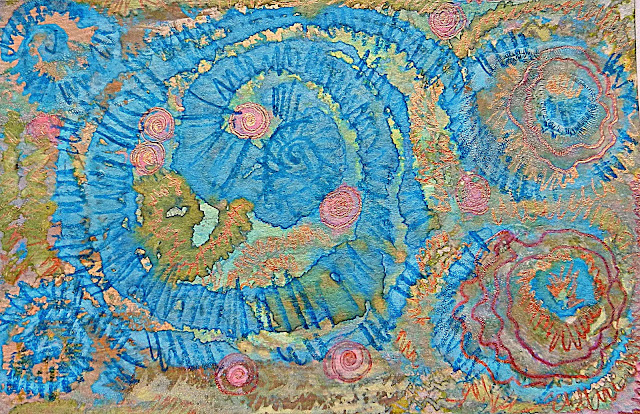"Apocalypto" extruded beads, placed in Bead Dreams competition
One of my earliest polymer mixed media pieces - mokume gane polymer disk,
steel, brass, textured polymer donut
'Ruffle' beads, colored with Genesis Heat-Set Oil Paints
"Tuareg" - Translucent Premo and Genesis heat-set oil paint -
published in Designer Showcase article in Belle Armoire Jewelry, Sept/Oct 2011
The
Emperor's Nightingale" - Mixed media piece - polymer, wire, acrylic paint,
handmade textures - private collection
"Everglades" necklace - polymer clay, heat-set
oil paint - private collection
Well, I’ve been called a ‘mad scientist’ since any and
all mediums are fodder for my experimentation when coloring polymer clay. In my
artistic life I’ve dabbled in most crafts, from pottery to fiber, rughooking,
knitting, professional dressmaking, papermaking, furniture painting, etc. My
brain seems to enjoy asking ‘what if?’ a lot and I never reject an artistic
idea, no matter how loony it sounds at the time! Having a background in many
craft processes, I can see how unusual combinations of things might be
serendipitous artistically. This is how innovation happens.
The medium that most mimics polymer for me is handmade
paper. In its liquid state, it is infinitely shapeable, taking the form of any
mold into which it’s poured. I loved the work I did with this medium when I
lived in Berkeley, CA back in the 80s and took classes at Fiberworks with Nance
O’Banion. So it doesn’t surprise me that I have lately been exploring the
marriage of polymer and paper in my work. The new Distress Oxide paints that I’ve
been exploring from Ranger really love paper, were made for it but all the
coloring media that work on polymer also work on paper.
"Kali" - Watercolor paper, acrylics, pen
"Can-can" - Watercolor paper, crayon, pens, Distress Paints
I’ve never been a polymer purist, thinking of myself as
more of a ‘mixed media artist working in polymer’. All the common wisdom of the
artistic (and art-as-a-business) community says I should stick with one idea and
squeeze every ounce of creative and financial juice out of it before moving on. I say, listen
to The Muse and let your intuition steer you out onto the vast waters of the
creative sea. Shift your paradigm and see what shows up.














Great article Christine. Your pieces are amazing!! Love the colors and shapes and the surprises you come up with in design and shapes. So glad you got them together here in one place!!
ReplyDeleteJ'aime énormément. Super. Merci pour l'inspiration.
ReplyDeleteYour pieces are so lovely and inspiring -thanks!
ReplyDeleteVery interesting to read an article about the development of polymer clay over time and the artistic phases you have gone through.
ReplyDeleteReally cool pieces from beginning to end, some I've had the pleasure of seeing.....keep it up. xox
ReplyDeleteI love the idea of being a "mad scientist" as that is a moniker that I have used from day one! I like the exploration of possibilities. I like texture and color and not paying attention to the rules of what can and can't be done. Lately I am doing abstract acrylic painting and finding that same fluid painting style is showing up in my polymer clay work in unexpected ways. Lovely evolution and wonderful pieces all. Enjoy the day. Erin
ReplyDeleteDo you sell your beads to the public?
ReplyDeleteWhich issue of stringing magazine were the little bumble beads published?
ReplyDelete